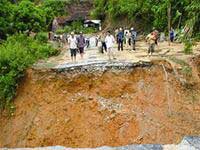In a short span of time, humanity has witnessed the devastating impacts of numerous storms. Why are storms appearing with increasing frequency and intensity?
 |
Devastation after a storm |
“The incidence of strong storms has nearly doubled in the past decade,” assert meteorological experts worldwide. However, the causes of this phenomenon remain highly debated.
Research from the Georgia Institute of Technology indicates that the increase in major storms is linked to prolonged global warming over several decades. This trend correlates with a steady rise in temperatures across nearly all tropical seas, which is not attributed to natural climate variability.
Sea surface temperatures in tropical regions are rising, warmer by approximately 0.5°C during the storm season compared to 35 years ago, since the 1970s. This provides optimal conditions for the formation of strong storms, as the fuel for storm creation is water vapor that rises, condenses, and releases heat when ocean temperatures exceed 26°C.
The higher the sea temperature, the more energy is available. Human activities, such as deforestation and environmental pollution, have contributed to the Earth no longer being as “cool” as it once was. Scientists warn that storms with destructive power comparable to Hurricane Katrina, with wind speeds over 56 m/s, may become more frequent in a warmer world.
However, some other scientists argue that the aforementioned study “needs more data to justify it.” They point out that of the 60 largest storms recorded since 1851, only 19 occurred after 1960. Excluding Hurricane Katrina, among the ten largest storms in history, five occurred before 1930, and only two occurred after 1970.
According to these experts, the recent surge in major storms is not primarily due to global warming exacerbated by human actions, but rather that “the world is undergoing a phase of increased major storms, which is part of a natural cycle that may last 20 years or more.”
No scientific study has yet been recognized as the definitive conclusion on this issue. Numerous computer simulation tests need to be conducted. Meanwhile, these tasks are not straightforward.
Vietnam is not exempt from the global climate changes
 |
| Storms and floods wash away a section of a national highway |
Meanwhile, Vietnam, a country traditionally considered to have few major storms due to its advantageous geographical location, recently faced Typhoon No. 7, internationally named Damrey, which was exceptionally powerful, marking a rare occurrence in the past decade on September 27th.
Mr. Le Van Thao, head of the Short-term Forecasting Department at the Central Meteorological and Hydrological Forecast Center, confirmed this after nearly a week of sleepless nights monitoring the storm.
He noted that it had been a long time since such a capricious and troublesome storm had formed. It originated at 7 PM on September 21st near the northern Philippines. Instead of continuing west-northwest towards mainland China, it rapidly intensified and changed direction due to high sea temperatures, around 28-30°C.
Within 24 hours, the storm continuously altered its path, moving north, then south, then turning northwest before veering southeast. The storm’s range was quite extensive, with its eye measuring 50-60 km in diameter, while the average eye of a storm is about 30 km.
The stronger the wind speed, the greater the centrifugal force, thus widening the storm’s diameter. An unusual characteristic of Typhoon No. 7 was its heavy rainfall in various areas, yet the total rainfall was not significant for a storm of its size; additionally, the occurrence of such a large storm during the transition to autumn—typically unfavorable for storm formation—is relatively rare in recent years.
The damage caused by Typhoon No. 7 primarily consisted of losses in agricultural products and seafood, indicating that forecasting efforts were timely and accurate. However, before the effects of Typhoon No. 7 had fully dissipated, Mr. Thao was already concerned about new threats.
As of now, the northwestern Pacific waters have experienced nearly twenty storms. Therefore, compared to the long-term average, there are likely to be at least ten more storms by the end of the year. Who can guarantee that among them, there won’t be strong storms like this one or even stronger making landfall in Vietnam?
The weather is becoming increasingly unpredictable, Mr. Thao admits, attributing much of this change to human actions that are responsible for the deteriorating global and national environmental conditions.
My Hang


















































